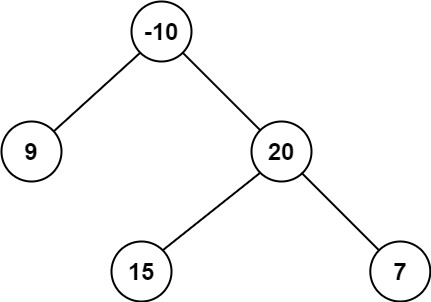[LeetCode][124]binary-tree-maximum-path-sum
Content
A path in a binary tree is a sequence of nodes where each pair of adjacent nodes in the sequence has an edge connecting them. A node can only appear in the sequence at most once. Note that the path does not need to pass through the root.
The path sum of a path is the sum of the node's values in the path.
Given the root of a binary tree, return the maximum path sum of any non-empty path.
Example 1:

Input: root = [1,2,3] Output: 6 Explanation: The optimal path is 2 -> 1 -> 3 with a path sum of 2 + 1 + 3 = 6.
Example 2:

Input: root = [-10,9,20,null,null,15,7] Output: 42 Explanation: The optimal path is 15 -> 20 -> 7 with a path sum of 15 + 20 + 7 = 42.
Constraints:
- The number of nodes in the tree is in the range
[1, 3 * 104]. -1000 <= Node.val <= 1000
Related Topics
Solution
1. 动态规划 + DFS
Java
class Solution {
int max = Integer.MIN_VALUE;
public int maxPathSum(TreeNode root) {
// The number of nodes in the tree is in the range [1, 3 * 10⁴]
// -1000 <= Node.val <= 1000
dfs(0, root);
return max;
}
/**
* 深度优先搜素
*
* @param sum 当前结点的父结点作为path的最后一个端点,path的最大sum
* @param node 当前结点
* @return 以当前结点作为起始端点的最大长度
*/
private int dfs(int sum, TreeNode node) {
if (null == node) {
return 0;
}
sum = sum <= 0 ? node.val : sum + node.val;
max = Math.max(max, sum);
int left = Math.max(0, dfs(sum, node.left));
int right = Math.max(0, dfs(sum, node.right));
// 在以当前结点为顶点的子树中,经过当前结点的最大值
int max0 = node.val + left + right;
max = Math.max(max, max0);
return node.val + Math.max(left, right);
}
}
public class TreeNode {
int val;
TreeNode left;
TreeNode right;
TreeNode() {
}
TreeNode(int val) {
this.val = val;
}
TreeNode(int val, TreeNode left, TreeNode right) {
this.val = val;
this.left = left;
this.right = right;
}
}